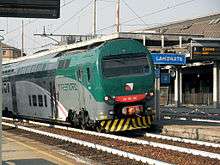Line S9 (Milan suburban railway service)
| Saronno–Albairate-Vermezzo | |||
|---|---|---|---|
|
| |||
 An S9 train at Milano Lambrate. | |||
| Overview | |||
| Type | Commuter rail | ||
| System | Milan suburban railway service | ||
| Status | Operational | ||
| Locale | Milan, Italy | ||
| Termini |
Saronno Albairate-Vermezzo | ||
| Stations | 15 | ||
| Website | Trenord (Italian) | ||
| Operation | |||
| Opened | 2004 | ||
| Technical | |||
| Track gauge | 1,435 mm (4 ft 8 1⁄2 in) | ||
| Electrification | 3,000 V DC | ||
| Route number | S9 | ||
| |||
The S9 is a commuter rail route forming part of the Milan suburban railway service (Italian: Servizio ferroviario suburbano di Milano), which converges on the city of Milan, Italy.[1]
The route runs over the infrastructure of the Novara–Seregno, Milan–Chiasso, Milan belt, Milan southern belt and Mortara–Milan railways. Like all but one of the other Milan suburban railway service routes, it is operated by Trenord.
Route
Line S9, a cross-city route, heads initially in an southeasterly direction from Saronno towards Cesano Maderno, Seregno, Monza and Milano Greco Pirelli, then runs via the Milan belt line and southern belt line around the eastern and southern sides of the Milan city centre, before finally heading southwest, to Albairate-Vermezzo.[2]
History
The S9 commenced operation on 24 December 2004, and initially linked Seregno with Milano San Cristoforo. Unlike the other lines in the suburban railway service, which offered services at half-hourly intervals, the S9 ran at a frequency of only one train per hour, in a narrower time band (from 07:00 to 20:00).[3]
Thanks to the activation of the S9, local passenger trains returned to the southern belt line after an absence of 10 years. Another peculiarity of the line was that it was the only one in the suburban railway service not to run along the Passante railway.
Initially, the S9 was managed by TiLo, a company formed ad hoc by Trenitalia and the Swiss Federal Railways. In March 2008, Trenitalia became the sole operator. Upon the timetable change on 13 December 2009, train services on the line became half-hourly throughout the day.[4]
In May 2009, following the merger of the Trenitalia's Regional Passenger Division with LeNORD, management of the line was taken over by the merged entity, Trenord.
On 12 June 2011, the line was extended from Milano San Cristoforo to Albairate-Vermezzo.
On 9 December 2012 the line was extended from Seregno to Saronno.
Stations
The stations on the S9 are as follows (the stations with a coloured background are within the municipality of Milan):[5]
| Station | Opened | Interchange | Note |
|---|---|---|---|
| Saronno | 1879 | ||
| Saronno Sud | 1991 | ||
| Ceriano Laghetto-Solaro | 2012 | ||
| Ceriano Laghetto-Groane | 2012 | ||
| Cesano Maderno-Groane | 2013 | ||
| Cesano Maderno | 2011 | ||
| Seveso-Baruccana | 2012 | ||
| Seregno | 1849 | ||
| Desio | 1849 | ||
| Lissone-Muggiò | 1882 | ||
| Monza | 1840 | ||
| Sesto San Giovanni | 1969 | ||
| Milano Greco Pirelli | 1914 | ||
| Milano Lambrate | 1931 | ||
| Milano Porta Romana | 1931 | | |
| Milano Romolo | 2006 | ||
| Milano San Cristoforo | |||
| Corsico | 2009 | ||
| Cesano Boscone | 2009 | ||
| Trezzano sul Naviglio | 1987 | ||
| Gaggiano | 1870 | ||
| Albairate-Vermezzo | 2009 |
Scheduling
As of 2012, S9 trains run every 30 minutes between 06:30 and 21:00 from Monday to Saturday. On holidays, S9 operates hourly from 08:00 to 21:00, but only between Milano Lambrate and Albairate-Vermezzo.[5]
See also
- History of rail transport in Italy
- List of Milan suburban railway stations
- Rail transport in Italy
- Transport in Milan
References
- ↑ "S come Suburbano" [S for Suburban]. Direzione Generale Infrastrutture e Mobilità website (in Italian). RegioneLombardia. Retrieved 20 November 2012.
- ↑ "Linee" [Lines] (PDF). Direzione Generale Infrastrutture e Mobilità website (in Italian). RegioneLombardia. Retrieved 20 November 2012.
- ↑ Canale, Andrea (March 2005). "...finalmente Passante!" [...finally, Passante!]. I Treni (in Italian) (268): 18.
- ↑ "Linee S in crescita" [S lines grow]. I Treni (322): 8. January 2010.
- 1 2 "Linea S9 Seregno - Milano S. Cristoforo - Albairate". Direzione Generale Infrastrutture e Mobilità website (in Italian). RegioneLombardia. Retrieved 20 November 2012.
External links
| Wikimedia Commons has media related to Milan suburban railway service. |
- ATM – official site
- Trenord – official site (Italian)
- Schematic of Line S9 – schematic depicting all stations on Line S9
This article is based upon a translation of the Italian language version as at November 2012.
